TLS Solution for MQTT and CoAP Protocols
Business and Implementation Plan
By Candice Smith 220484184, 25/07/2024
Introduction
Redback Operations is dedicated to revolutionizing the fitness experience by developing state-of-the-art connected fitness devices that not only enhance the enjoyment of physical activity but also its effectiveness. These devices are designed to transmit information regarding the identity, behaviours and health of its users, data outlined by the Redback Operations Security Guidelines as being sensitive information, protected by the Privacy Act 1988 ("Privacy Act"). For this reason, ensuring that communication is secure is of foremost importance. With this report we seek to outline the current state of security for data in transit from Redback Operations devices utilising either the MQTT or CoAP protocols. We seek to outline associated risk and propose an implementation plan for a solution that will enhance the security posture across all associated devices.
Definitions
| Term | Definition |
|---|---|
| CoAP | Constrained Application Protocol -- UDP based internet application protocol for constrained devices. |
| Data Lakehouse | Database architecture that combines data lake and data warehouse benefits, by introducing table metadata to files in object storage. |
| ECDSA Certificate | Elliptic Curve Digital Signature Algorithm |
| Encryption | The process of converting plain, readable text to unreadable ciphertext to protect data. |
| MQTT | Message Queuing Telemetry Transport -- common protocol used with IoT devices. |
| Security Posture | An organisation's strength and resilience in relation to predicting, preventing, and responding to cyber threats. |
| TLS | Transport Layer Security |
| UDP | User Datagram Protocol |
TLS Solution
TLS is a cryptographic protocol that works by setting up a secure connection through a process called the TLS Handshake. This is performed between a client and server and allows them to communicate in a secure way that ensures data is protected by encryption from eavesdropping, manipulation, and other attacks by providing confidentiality, authenticity, and integrity. During the TLS Handshake a client initiates a request known as the 'Hello' message to a server and the server then responds with it's 'Hello' message. Once this connection is established an authentication check is done to ensure that the server houses a valid digital certificate including a private key. If there is no active valid certificate installed, it has expired, or it has been revoked, the TLS Handshake will fail, and a connection will not be established. If an active certificate is present, the client and server complete the TLS handshake, the server's identity is authenticated, and an encrypted session is established. The client and server can then communicate securely with all data encrypted by the session keys.
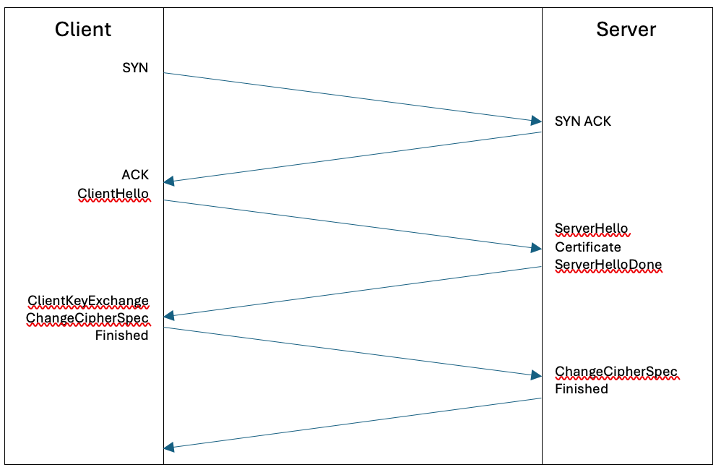
Mutual TLS, or mTLS as it is known, uses the same technology as TLS but instead of having a certificate installed only on the server side, it requires a second certificate to be installed on the client side. The TLS process operates in the same way as above but allows for the identity of the server and the client, such as IoT devices to be authenticated. MTLS offers a much higher level of assurance and risk mitigation of data breach than regular TLS due to the additional authentication but is a more complex solution to implement. It should be considered in future due to the data being transmitted and associated privacy responsibilities, but this is currently out of scope for the initial Proof of Concept and Implementation.
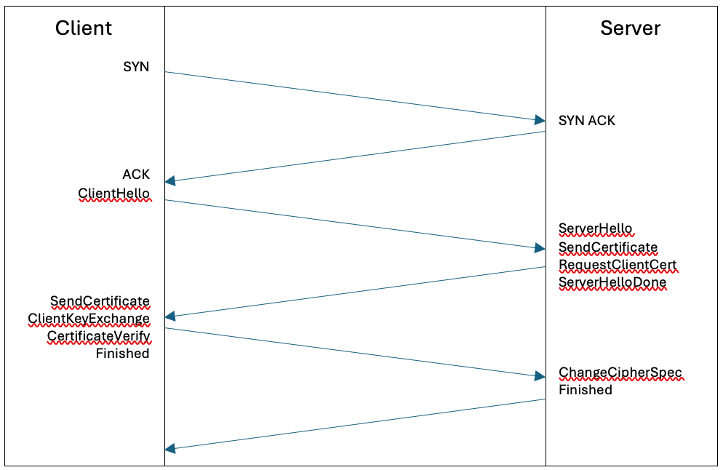
Application of TLS Solution
TLS can be applied to a vast array of use cases, including, but not limited to securing websites, securing IoT communication and connections, email security, API security, VPN connection, FTP file transfers, secure software update downloads, cloud services, authentication via OIDC or similar and secure payments. Given the nature of the information being captured and communicated throughout the Redback Operations environment but internal and external, having encryption and authentication in place to protect that data is a critical, proactive measure that can be taken to secure that data.
While this implementation focuses on securing MQTT and CoAP communications there are likely many additional use cases that can be uncovered for the application of TLS in a very similar way, utilising the Let's Encrypt and Certbot combination. This can be used for the mobile app that is being developed, for the company website, for any APIs that are to be utilized, for the database server, as just a start. This planning document serves as the framework and guidelines for any future application of TLS in the Redback Organisation.
Current State
Overview
Redback Operations have implemented a messaging protocol allowing their devices to feed data to a central database where it can be processed to provide value to users in diverse ways. The currently utilized protocol is MQTT, which is a lightweight protocol that is scalable and reliable and a common way to connect IoT devices over the internet. There is a current review assessing the viability of CoAP as an alternative protocol allowing an even more lightweight solution improving speed of processing, though there is not a current implementation for this protocol. Redback Operations Project 1 has plans to switch to CoAP later this semester from the current MQTT communications.
Currently MQTT is used throughout the organisation in several ways. Project 1 is using MQTT to communicate between a Raspberry Pi attached to their smart bike, their VR game and are working toward communicating with their mobile app. They are using a HiveMQ broker but have access issues, and are looking into using data warehousing's VM's MQTT broker which relies on Mosquitto. Project 4 -- Orion previously undertook an assessment of various MQTT Servers, or Brokers, and identified the recommended services to be provided by HiveMQ. This was followed by an Implementation Plan and subsequent implementation of HiveMQ as the broker for Project 1. The focus for this team was deployment of a functional solution for the transmission of data collected by the Redback devices, and sent back to a central database, currently Mongo DB is utilized by some project teams, with a proposal to adopt Dremio as a Data Lakehouse. Here is an overview of current Project 1 related architecture:
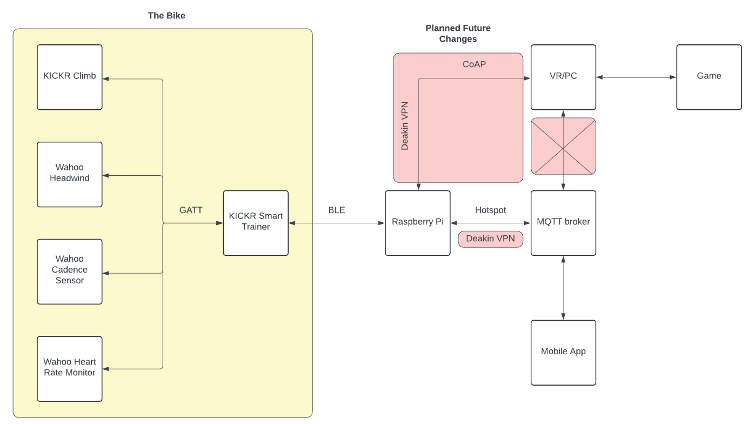
Overview of broader proposed architecture including additional provision of services such as web server, API and NTP server:
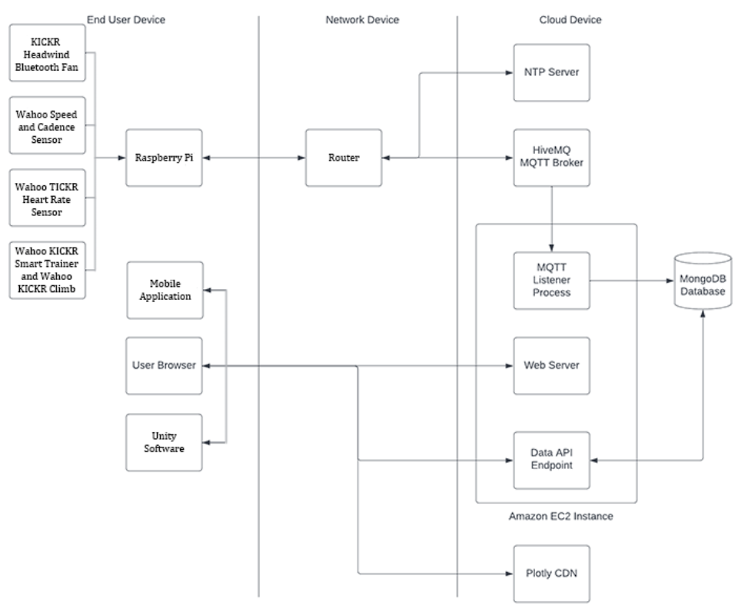
It has been recognized that the data Redback Operations is handling requires protection as it is sensitive and protected by the Privacy Act. Redback Operations is responsible for ensuring health, personal and biometric data collected or transmitted by our devices is protected from data leakage or breach.
Current Architecture
MQTT Architecture
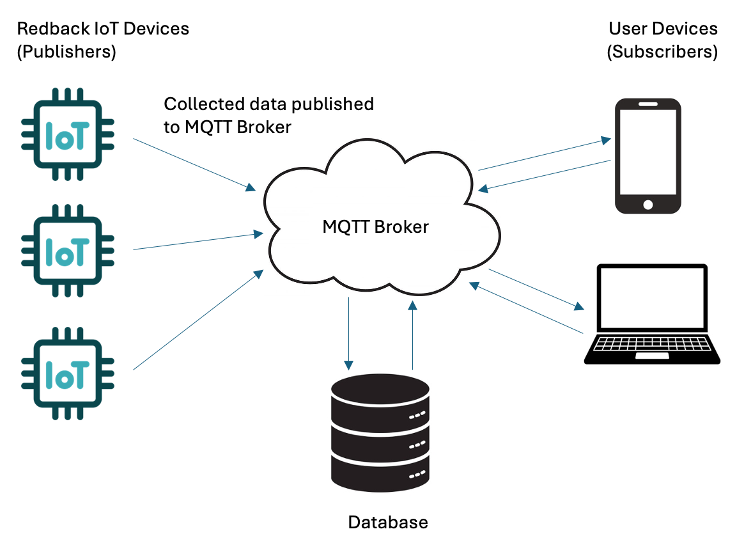
Central to an MQTT architecture is the MQTT Broker. There are several MQTT Brokers available for implementation, Redback Operations currently utilise two solutions, HiveMQ, and Mosquitto. The current HiveMQ broker is hosted as a serverless cloud service offering usage limited to 100 free connections, 10GB data traffic per month, MQTT versions 3.1, 3.1.1, 5.0, WebSocket support, basic authorization rules and most relevant to this report is the included MQTT over TLS/SSL offering. Some of risks associated with this broker are that it includes basic authorization rules, but does not offer any opportunity to configure the broker as a developer, and there is an elevated risk with this being a shared MQTT platform. This may mean it carries a higher risk of unauthorized access or data breach. The limit of 100 connections presents an issue with scalability, particularly if this is utilized as a companywide service connecting with all devices utilising MQTT. HiveMQ identify this service as being suitable only for basic MQTT learning and experimenting and the application of this in Redback long term will likely not be suitable. Finally uptime may be an issue as there are no uptime SLAs for this solution.
The Moscquitto MQTT Broker is hosted within the on-premise infrastructure for Redback Operations on a virtual machine that can be accessed via SSH. This service will offer greater configuration opportunity, greater control, and greater scalability. If managed well it may offer greater reliability than the free cloud based HiveMQ broker and it is possible for this broker to be deployed at scale as it supports thousands of connections well, not millions though, which should not be an issue for the scale of the Redback organisation. Mosquitto offers the ability to integrate with Mongo DB which is potentially a critical requirement of the Redback Operations environment.
All other components of the MQTT architecture, called clients, connect to the MQTT Broker and act as a publisher or subscriber. IoT Devices that include sensors and other technologies used for gathering data typically act as publishers, feeding data to the Broker to distribute to other clients in the network. These other clients subscribe to receive data from the broker based on categorisation called topics. When publishers send their data to the Broker it is labelled with a topic, that information is then distributed only to the devices that subscribe to the associated topic.
CoAP Architecture (proposed only)
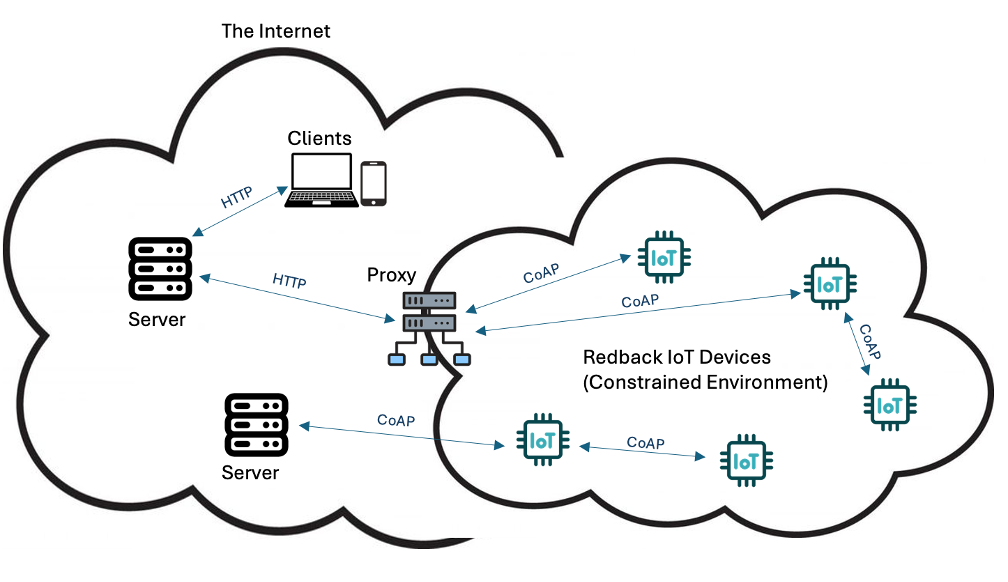
CoAP is a protocol that has many similarities to HTTP, which makes it easy to implement for developers with an existing understanding of HTTP. Like HTTP, CoAP operates on a request-response communication model where a client sends a CoAP request to a server and the server responds with the requested data using GET, PUT, POST and DELETE methods. CoAP is suitable for both device-to-server communication and machine-to-machine communication, and it uses UDP which is a connectionless protocol rendering the solution lighter than MQTT. One compromise with CoAP is that it does not guarantee reliability by default, but requires a selection from confirmable, non-confirmable and acknowledgement.
Current Policies
There are currently several policies in place that require review to assess whether the MQTT TLS solution should be included:
-
Cyber Security Guidelines: Project 1
-
Cyber Security Guidelines: Project 3 -- Wearable Technologies for Elderly People
-
Cyber Security Guidelines: Project 7 -- Smart Bike Project
-
Cryptography Policy
-
Endpoint Security Policy
-
External Attack Surface Management Policy
-
Server Security Policy
Risks - MQTT
The number of known vulnerabilities with MQTT are growing year on year with 23 known vulnerabilities in 2020, and 33 being recorded in 2021 with 18 of those being listed as critical vulnerabilities. Many of these are still not patched today. Some examples are:
-
Use of insecure default configurations designed to prioritize ease of use over security.
-
In Eclipse Mosquitto to version 2.0.5, establishing a connection to the Mosquitto server without sending data triggers a process resulting in excessive CPU consumption. This could be used by a malicious actor to perform a denial-of-service type attack.
-
Remote code execution attacks can be caused by buffer overflow vulnerabilities allowing bad actors to inject and execute malicious code on IoT devices.
Aside from the above vulnerabilities with MQTT, which can mostly be mitigated by ensuring the most recent updates and patches are applied, the key issue with the deployment of MQTT within the Redback Operations environment is that it is not currently secured using a TLS solution. This is an optional feature of an MQTT configuration and without TLS applied all data is transmitted in plain text meaning it is vulnerable to data leak or data breach.
Risks - CoAP
There are some good benefits of using CoAP -- it is a lightweight protocol, often preferred for gathering telemetry data. Like devices using MQTT, devices using CoAP are often reachable via public facing IP addresses accessible from the internet. This creates insecure end points where data can leak, DDoS attacks can be carried out, and access can be exploited.
Unlike the MQTT protocol, CoAP incorporates DTLS, which is based on the TLS protocol. The difference being DTLS uses UDP, which is the transport layer CoAP uses. Like TLS, DTLS will provide encryption, but also makes sure that the content cannot be altered by third parties along the network path. DTLS requires a valid EDCSA certificate with a preference to have been issued by a trusted CA to avoid the issues and vulnerabilities that go along with self-signed certificates.
Proposed Future State
Overview
Both the MQTT and CoAP require a TLS x.509 certificate to ensure the data being transmitted is encrypted and not delivered in plain text. The solution proposed will enable TLS for the current MQTT related architecture and outlines the application of TLS for a suggested application of CoAP.
Architecture - MQTT
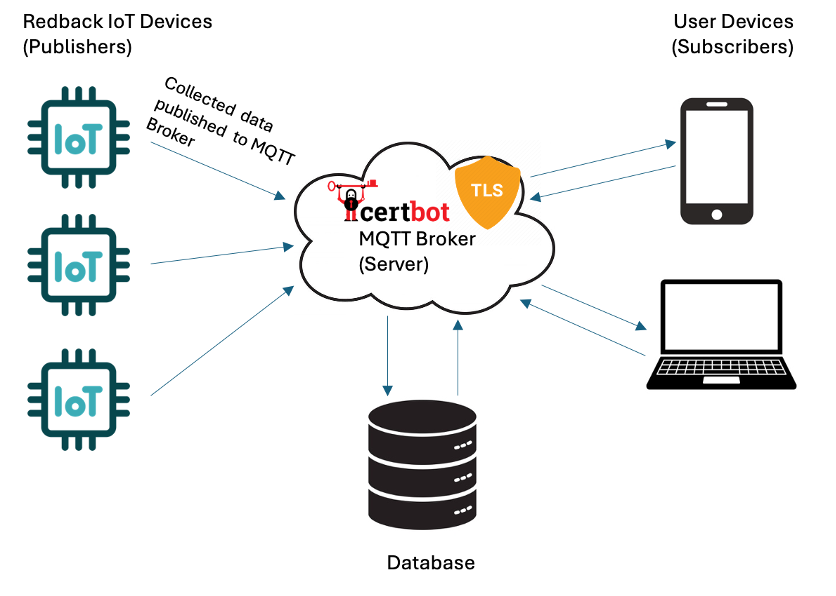
To implement a TLS solution for an MQTT architecture we need to install a certificate on the MQTT Broker. We have reviewed the use of Let's Encrypt certificates and have identified them as being a feasible solution in conjunction with Certbot to manage the renewal of those certificates every 90 days. It is possible to implement mTLS by adding certificates to the clients as well as the server, but this is optional. It is also possible to use self-signed certificates to establish this connection, but that requires the root certificate to be installed on all clients to establish and maintain trust. Once the certificates are installed, configuration must occur on both the client and broker side to facilitate the secured connection TLS offers.
MQTT Server TLS Implementation
*Please refer to PoC Retrospective document for validated process
-
Connect to the Redback Ops server containing the MQTT Broker (Mosquitto) via SSH.
-
Check Mosquitto is installed and running by entering the following command:
sudo systemctl status mosquitto -
Ensure Certbot is not already installed -- the expected return is nothing:
which certbot -
Install Certbot, commands are dependent on OS:
sudo apt update
sudo apt install certbotAdditional details can be found here: https://certbot.eff.org/instructions
-
Ensure you have a domain associated with your server IP, for this instructional we'll refer to it as mqttserver.domain.com
-
Prove domain control and obtain a certificate:
sudo certbot certonly \--standalone -d mqttserver.domain.com -
You should now be able to locate the certificate files in /etc/letsencrypt/live/yourdomain.com/.
-
Locate files: fullchain.pem (cert file), and privkey.pem (private key)
-
Copy Mosquitto config file -- usually found at '/etc/mosquitto/mosquitto.conf' rename copy as '/etc/mosquitto/tlsconf.d/'.
-
Add the following code to enable TLS:
listener 8883
cafile /etc/letsencrypt/live/mqttserver.domain.com/chain.pem
certfile /etc/letsencrypt/live/mqttserver.domain.com/fullchain.pem
keyfile /etc/letsencrypt/live/mqttserver.domain.com/privkey.pem
tls_version tlsv1.2
-
listener 8883 specifies the port for TLS connections (default is 8883 for TLS).
-
cafile points to the CA certificate file (part of the Let's Encrypt chain).
-
certfile points to your server certificate.
-
keyfile points to your private key.
-
tls_version specifies the minimum TLS version to use.
-
Restart Mosquitto to apply the config changes:
sudo systemctl restart mosquitto -
Verify config by testing with MQTT Clients
mosquitto_sub -h mqttserver.domain.com -p 8883 -t test/topic \--cafile
/etc/letsencrypt/live/mqttserver.domain.com/chain.pem*You may need to adjust the port -- please review
-
In the case a client fails to connect, check Mosquitto logs for errors.
sudo journalctl -u mosquitto -
Once TLS secured connection is active, automate certificate renewal.
-
Check to see if Certbot has a cron job or systemd timer set up correctly:
sudo systemctl list-timers*You are looking for "certbot.timer".
-
Reload Mosquitto config after successful renewal:
sudo nano /etc/letsencrypt/renewal-hooks/post/reload-mosquitto.sh
#!/bin/bash
systemctl reload mosquitto
sudo chmod +x /etc/letsencrypt/renewal-hooks/post/reload-mosquitto.sh
Raspberry Pi TLS Implementation for mTLS option
For reference if an mTLS solution is required in future. Below process will need to be tested and validated.
-
Start by ensuring system is updated:
sudo apt update
sudo apt upgrade -
Install Certbot, this is the command for all OS except Apache:
sudo apt intall certbot -
Ensure you have a valid domain name pointing at your IP, and that port 80 and port 443 are not blocked. If you are using Cloudflare DNS services have the DNS set to bypass proxy servers. Ensure port 80 is also forwarded.
-
Let's assume we are not running Apache, we now need to grab a Let's Encrypt cert using the built in standalone python server:
sudo certbot certonly \--standalone -d devicedomain.com -d www.devicedomain.com -
Enter required detail for Let's Encrypt as prompted. Certificate should then be issued. If you experience issues double check settings in question 3 and try again.
-
Certificates should now be stored at /etc/letsencrypt/live/devicedomain.com/
-
Installing the certificate (this is a NGINX guide, you may need to redefine for other OS), start by opening NGINX config file:
/etc/nginx/ or /etc/nginx/sites-available/
-
Open file in text editor and look for a block as follows:
server
{
listen 80 default_server;
listen \[::\]:80 default_server;
root /usr/share/nginx/html;
index index.html index.htm;
server_name devicedomain.com;
location /
{
try_files \$uri \$uri/ =404;
}
} -
In this code block, find:
listen \[::\]:80 default_server -
Below this line we will need to add an additional command to instruct NGINX to listen on port 443, which is the port that handles HTTPS/SSL traffic and web browser connections:
listen 443 ssl; -
Find:
server_name example.com; -
Below this add:
ssl_certificate /etc/letsencrypt/live/devicedomain.com/fullchain.pem;
ssl_certificate_key /etc/letsencrypt/live/devicedomain.com/privkey.pem; -
NGINX now knows how to locate the certificate files for the TLS Handshake, and decryption.
Architecture - CoAP
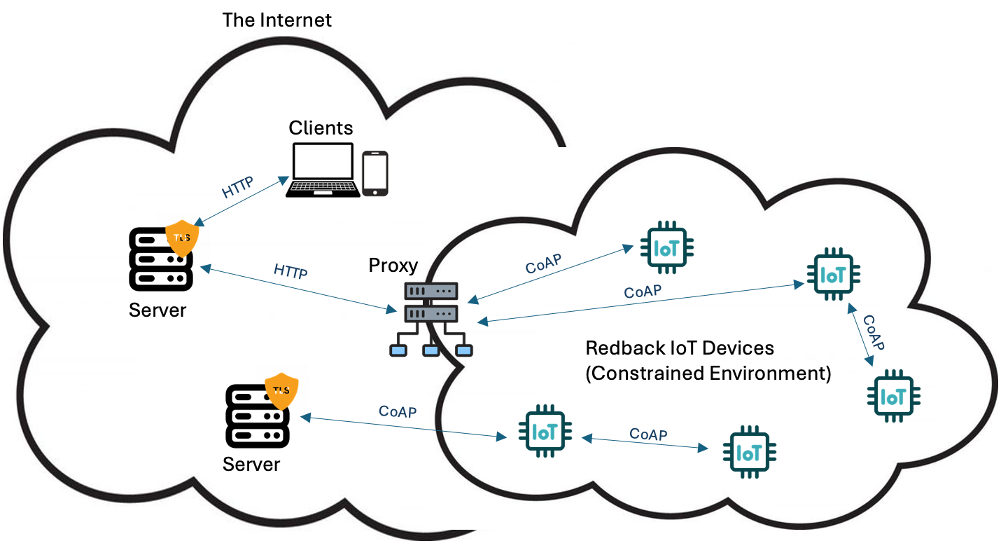
In the case of CoAP we need to issue and install ECDSA certificates onto the CoAP server(s). As we are using DTLS, rather than TLS, we need to convert the certificate files from .pem to PKCS12 format for them to be usable in this context. We then configure the CoAP server -- these are most commonly Eclipe Californium or libcoap based -- and set up the KeyStore and TrustStore. As in the case of MQTT, if you choose to implement mutual authentication, certificates can be installed on clients, but this is not essential.
CoAP Implementation
-
Set up CoAP server within the on-premises, or cloud environment, and ensure it has an associated domain that we can prove control of.
-
Install Certbot -- this is dependent on which OS you are utilising, command line instructions can be found here: https://certbot.eff.org/instructions . An example of this is:
sudo apt-get update
sudo apt-get install certbot -
Prove domain control (coapserver.domain.com) and obtain an ECDSA certificate:
sudo certbot certonly --standalone --preferred-challenges http --key-type ecdsa -d coapserver.domain.com -
You should now be able to locate the certificate files in /etc/letsencrypt/live/coapserver.domain.com/.
-
Locate files: fullchain.pem (cert file), and privkey.pem (private key)
-
Because we are using DTLS, not TLS we need to convert the .pem files to PKCS12 format
openssl pkcs12 -export -in /etc/letsencrypt/live/coapserver.domain.com/fullchain.pem -inkey /etc/letsencrypt/live/coapserver.domain.com/privkey.pem -out coap-server.p12 -name "coap-server" -
You may need to extract key and certificate from the P12 file:
openssl pkcs12 -in coap-server.p12 -nocerts -out coap-server.key -nodes
openssl pkcs12 -in coap-server.p12 -clcerts -nokeys -out coap-server.crt -
Next you will need to configure your CoAP server with DTLS -- the commands will depend on your chosen CoAP implementation. A popular option is libcoap where you would perform the following commands:
Install libcoap:
sudo apt install libcoap2 libcoap-devConfigure DTLS on your CoAP server:
TBC - CoAP server must be identified -
Ensure CoAP server is running and configured with DTLS.
-
Test using CoAP Client library:
coap-client -m get -u "your-username" -k "your-password" coaps://coapserver.domain.com/resource
Risk Mitigation and Best Practice
There are several actions we can take to mitigate risk and apply best practice. These include:
Enabling encryption of data transmitted using MQTT connections through Transport Layer Security (TLS) ensures confidentiality and integrity.
Ensure you regularly check for and apply any updates and patches released by your MQTT software vendor. You may need to update your broker, clients and libraries to ensure you are addressing vulnerabilities as they are discovered.
Monitoring and intrusion detection practices are critical in both MQTT and CoAP environments to identify and respond to suspicious activity on either network.
In a CoAP based environment ensure both DTLS and ECDSA are utilised. The combination of the two will provide the best security and the best performance.
Key rotation is important in both MQTT and CoAP. The shorter the life of your keys the more secure your environment is, as any vulnerability relating directly to the key in use is mitigated by rotating to the new key. It means there is only a limited time attackers have to 'break' your cryptographic key and assume control of your data and systems. With Let's Encrypt, certificates have a maximum lifespan of 90 days, and they are rotated automatically with the use of Certbot.
Key Storage is also very important and in the case of any key and secret storage, these assets are best held within an HSM, whether it be hardware or software based.
Feasibility Assessment
Technical Feasibility
Certificate Issuance and Management
By using a combination of Let's Encrypt and Certbot certificates can be successfully issued and installed in both the MQTT and CoAP use cases. Certbot ensures that certificates are rotated as required to provide continuity of valid certificates on the server or device we are protecting.
Certificate Details
The certificates issued by Let's Encrypt are in .pem format. This format is suitable for MQTT but not for CoAP. However, CoAP can utilise a .p12 certificate file which can be derived from converting a .pem file into this format. CoAP also requires the use of an ECDSA based certificate which utilises an Eliptic Curve based algorithm for encryption. In this way we can cover both use cases successfully.
MQTT Broker Configuration
Redback Operations use both Mosquitto and HiveMQ Brokers, and both of these options do support TLS.
Financial Feasibility
The above solutions are all free of charge, so pose a feasible option from a financial perspective. The components are Certbot to handle certificate automation, and Let's Encrypt to issue free digital certificates. These tools are presented with a recommendation to utilize a Mosquitto MQTT broker which is also free of charge.
Operational Feasibility
The proposed solution is relatively simple to deploy and incorporate into operational process as a standard across the organization. It can be incorporated into the management and associated development of Redback Operations end points and does not add great complexity to current processes. The benefit of standardizing the use of this TLS solution for MQTT and CoAP is that it greatly reduces risk of data compromise and improves the overall security posture of the organization. This is a lightweight solution that should not jeopardise performance or scalability of Redback Operations product offering.
Security Feasibility
The addition of TLS for MQTT and DTLS for CoAP will each add great security benefit as it results in encrypted data hidden from attackers or eavesdroppers within the Redback environment. It also protects data from being tampered with. The other benefit for these solutions is authentication. These security protocols allow a process of authenticating a server to a client to ensure they are communicating with the legitimate machine.
Change Management
Planning:
- Define objectives and scope.
- Define current state.
- Define proposed future state.
- Assess current knowledge and skill level for this solution.
- Engage current stakeholders including developers of IoT and other appliance code, owners of end points including authority for current MQTT infrastructure, Project Team Leaders, Organisation Leaders.
Design and Configuration:
- Design TLS for MQTT solution, configuration, and security policies.
- Design DTLS for CoAP solution, configuration, and security policies.
- Record all planning and design content within Business and Implementation Plan Document.
Pilot Implementation:
- Set up and configure TLS certificates and MQTT brokers and clients for single use case.
- Set up and configure DTLS certificates and CoAP brokers and clients for single use case if available.
Testing and Validation:
- Validate and record step-by-step guide for use as an enablement tool.
- Perform functional, security, and performance testing.
- Optimize configurations as needed.
Org-wide Deployment:
- Ensure enablement materials are in place prior to broader deployment.
- Map additional use cases and applicable projects.
- Plan and execute deployment of solution to wider organisation.
Post-Deployment:
- Monitor, maintain, and manage certificates.
- Update documentation and provide training.
- Review and implement improvements.